The Cu Chi Tunnels stand as one of Vietnam’s most remarkable testaments to human ingenuity and determination in the face of overwhelming odds. This vast underground network, spanning over 250 kilometers beneath the Cu Chi district of Ho Chi Minh City (formerly Saigon), played a pivotal role in the Vietnam War and has since become an iconic symbol of Vietnamese resilience.
This article explores the complete Cu Chi Tunnels history, from their humble beginnings during the French occupation to their expansion during the Vietnam War, and finally their preservation as one of Vietnam’s most visited historical sites today.
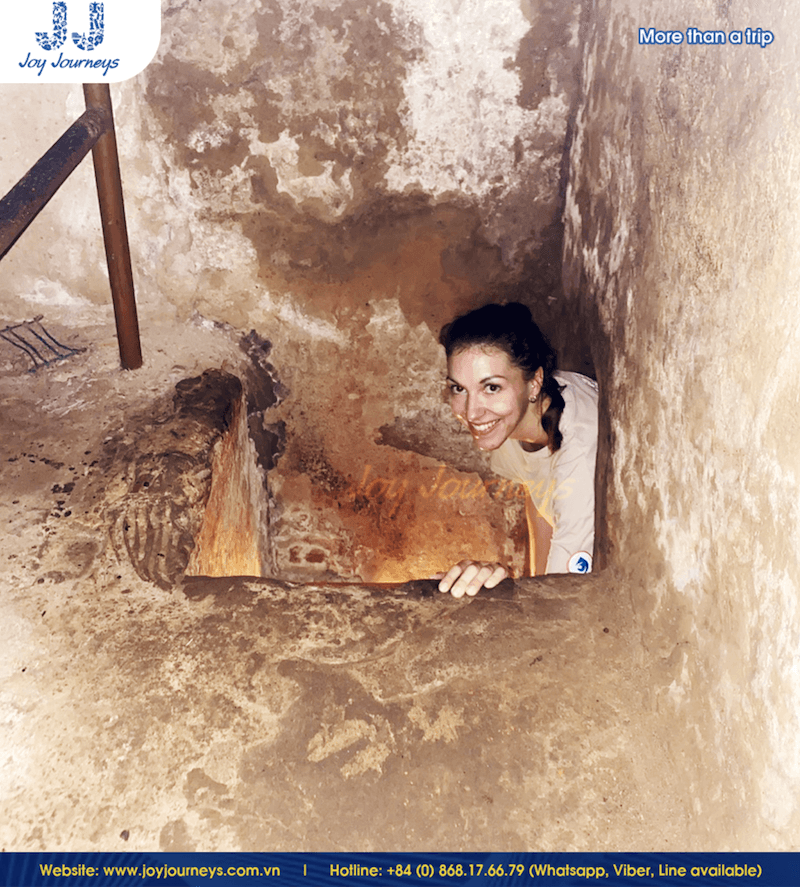
Contents
Cu Chi Tunnels History: The Early Stages of Construction
The First Tunnels
The history of Cu Chi Tunnels begins in the 1940s during the First Indochina War against French colonial forces. Anti-colonial Viet Minh fighters first began digging these underground passages in 1948 as a response to French military superiority. Initially, these were simple, fragmented tunnels and chambers designed primarily for sheltering resistance fighters, hiding confidential documents, and storing weapons.
The construction process was painstakingly slow and dangerous. Tunnels were often dug by hand using rudimentary tools like hoes and crowbars, with workers advancing only short distances at a time. The soil excavated from these early tunnels had to be carefully disposed of-typically scattered in nearby rivers at night or spread across bomb craters under cover of darkness-to avoid detection by French forces.
Who built the Cu Chi tunnels? The earliest tunnels were constructed by local villagers and Viet Minh resistance fighters, many of whom had no formal engineering training but possessed remarkable determination and resourcefulness. They took advantage of the region’s compacted red clay soil, which was ideal for tunnel construction as it held its shape well and remained sturdy even without substantial reinforcement.
Cu Chi Tunnels Vietnam War: Expansion and Layered Architecture
When were the Cu Chi tunnels built to their full extent? While the initial network was constructed in the late 1940s, the system underwent dramatic expansion during the escalation of the Vietnam War in the 1960s. What had begun as isolated, disconnected tunnels evolved into an intricate network connecting multiple hamlets and eventually spanning the entire Cu Chi district.
By 1961-1965, one of the most intense periods of the Cu Chi tunnels Vietnam War involvement, the northern communes of Cu Chi had constructed what became known as the “backbone”-the main tunnel line from which numerous branch tunnels extended, connecting various hamlets, communes, and strategic locations. The network ultimately grew to link villages from the Saigon River all the way to the Cambodian border.
The tunnels were incredibly sophisticated for their time, featuring three distinct levels:
- The top level, approximately 3 meters underground;
- The middle level, around 6 meters below the surface;
- The deepest level, extending 12 meters underground in heavily bombed areas.
This multi-level design provided crucial protection against American bombing campaigns and allowed for complex defensive strategies that would prove decisive throughout the conflict.
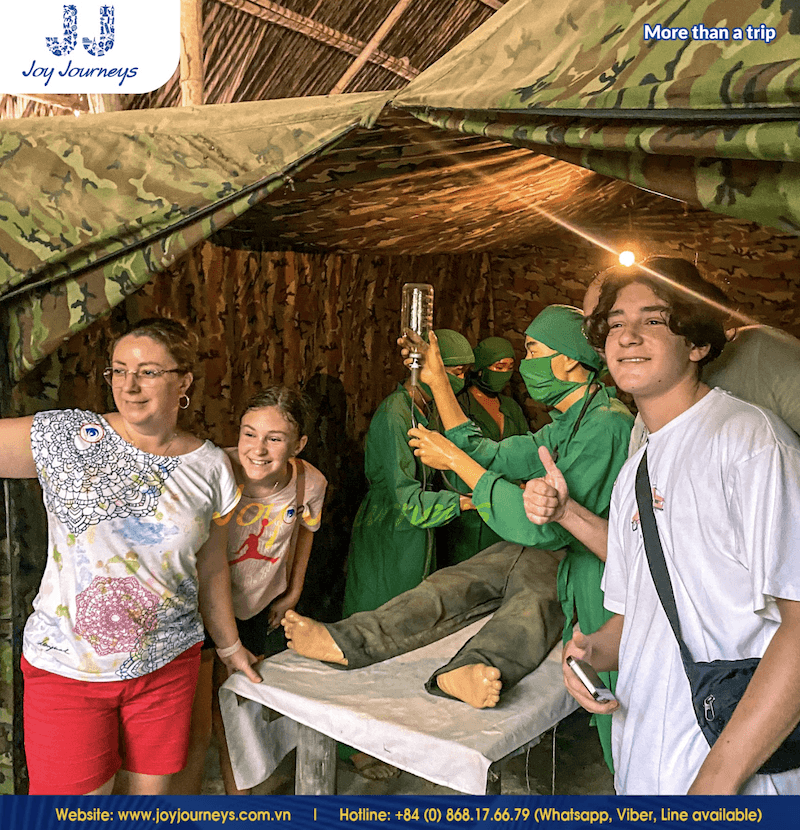
Life in the Cu Chi Tunnels
Cu Chi Tunnels History: Daily Life Underground
Life in the Cu Chi tunnels was characterized by extreme hardship and remarkable adaptation. American soldiers aptly named the conditions the “Black Echo” due to the perpetual darkness and oppressive atmosphere that permeated the underground network.
For the Vietnamese who lived and fought from these tunnels, daily existence was fraught with challenges. Air, food, and water were scarce commodities, and the confined spaces were shared with various unwelcome inhabitants-ants, venomous centipedes, snakes, scorpions, spiders, and rodents. The air inside was often stifling, becoming so hot by afternoons that inhabitants would lie flat on the ground to breathe more easily.
The absolute darkness was so intense that some tunnel residents, after prolonged stays underground, temporarily lost their sight upon emerging into daylight. Despite these conditions, the tunnels were organized with remarkable efficiency, featuring designated areas for:
- Sleeping quarters;
- Kitchens with ingenious Hoang Cam stoves (designed to disperse smoke horizontally through multiple chambers to prevent detection);
- Rudimentary hospitals where operations were conducted using instruments fashioned from bomb shards;
- Meeting rooms for military planning and political education;
- Storage facilities for weapons, food, and medical supplies.
Exploring Cu Chi Tunnels Facts: The Tunnel Community
As American bombing intensified, entire communities moved underground, transforming the Cu Chi Tunnels into subterranean villages. This pivotal chapter in Cu Chi Tunnels history saw inhabitants adopting a nocturnal routine—remaining hidden during daylight and emerging at night to tend crops, gather supplies, or engage enemy forces.
During periods of heavy bombing or increased American troop movements, people might remain underground continuously for weeks. This underground society developed its own rhythm and culture, with specialized roles for different members. Some focused on tunnel maintenance, others on food production, healthcare, or military operations.
Despite the harsh conditions, efforts were made to maintain morale. Remarkably, the tunnel network even featured theaters and music halls in some sections, where performers would entertain troops and civilians with patriotic songs and plays. These cultural activities played a crucial role in maintaining the psychological resilience of the tunnel communities.
Survival Tactics: A Key Part of the History of Cu Chi Tunnels
Health concerns presented a constant challenge in the tunnels. Malaria was rampant, becoming the second-largest cause of death after combat wounds. A captured Viet Cong report suggested that at any given time, approximately half of a PLAF (People’s Liberation Armed Forces) unit suffered from malaria, and “one-hundred percent had intestinal parasites of significance.”
To counter these health challenges, the tunnels featured rudimentary medical stations where practitioners used a combination of Western medicine (often procured by bribing ARVN soldiers in Saigon) and traditional Vietnamese remedies. Medical supplies included herbs, acupuncture, and honey for its antiseptic properties.
Food scarcity required creative solutions. The primary staple was tapioca (cassava), supplemented with whatever leaves, roots, and other edible plants could be gathered. Tunnel residents became experts at maximizing limited resources-recycling materials, using bomb fragments as tools, and developing food preservation techniques suitable for underground storage.
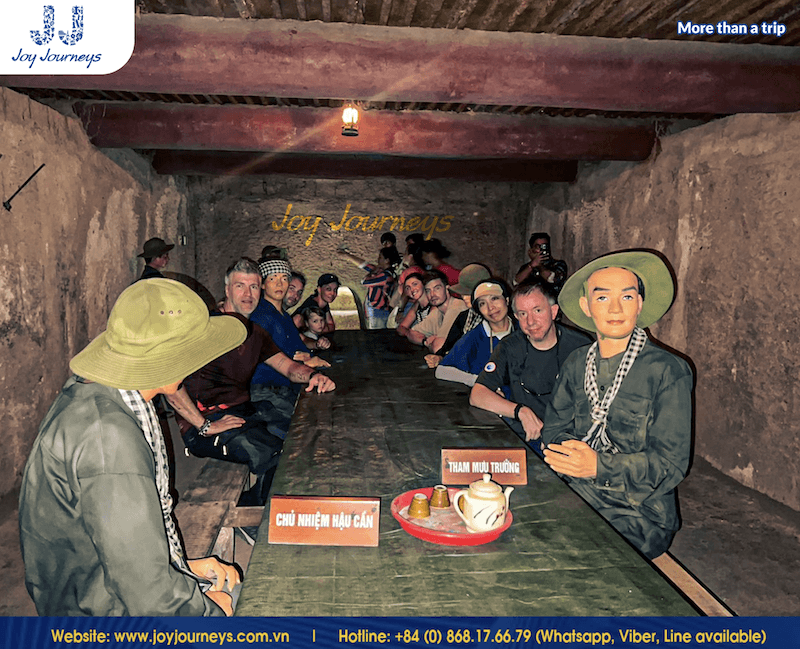
The Tunnels’ Role in the Vietnam War
A Strategic Advantage
The Cu Chi tunnels represented a strategic masterstroke that effectively neutralized many of America’s technological and firepower advantages. By 1965, the Viet Cong had become so well entrenched in the tunnel system that they could dictate the terms of engagement-choosing when and where battles would take place, then disappearing underground before American forces could respond effectively.
How long are the Cu Chi tunnels in their entirety? The complete network stretched over 250 kilometers, with numerous branches, levels, and chambers creating a labyrinthine system that proved nearly impossible for American forces to map or destroy. This underground city allowed Vietnamese fighters to:
- Move unseen throughout the countryside;
- Launch surprise attacks against American and South Vietnamese positions;
- Establish bases within walking distance of Saigon and even the main U.S. military headquarters;
- Maintain supply lines that were virtually immune to aerial bombardment.
Significantly, the Cu Chi district’s location-just 70 kilometers northwest of Saigon-allowed the Viet Cong to maintain a presence virtually on the doorstep of the South Vietnamese capital and American military command.
Guerilla Warfare Tactics
The tunnel system facilitated sophisticated guerrilla warfare tactics that fundamentally shaped the conflict. Tunnel entrances-often no larger than an A3 paper size-were meticulously concealed with natural materials and booby traps, making them nearly invisible to American patrols.
Above ground, the Viet Cong deployed an array of ingenious traps designed to injure, immobilize, or kill enemy soldiers. These included:
- Punji sticks (sharpened bamboo spikes, sometimes coated with animal manure to cause infection);
- Revolving trap doors concealing pits lined with spikes;
- Spring-loaded “clipping armpit” traps;
- Swinging mace traps triggered by tripwires;
- “Fish trap” style devices that allowed entry but prevented exit.
When American forces adapted to simple spike traps by issuing better boots, the Viet Cong responded by modifying their traps to target other vulnerabilities. This constant tactical evolution epitomized the resourcefulness that characterized the entire tunnel complex.
The Americans attempted numerous countermeasures, including:
- Deploying specialized “tunnel rat” soldiers trained to enter and clear tunnel sections;
- Using trained dogs to detect tunnel entrances (countered by the Vietnamese sprinkling pepper around entrances to confuse the animals);
- Pumping gas into tunnel entrances;
- Attempting to flood tunnel sections;
- Using chemical defoliants to remove jungle cover.
Despite these efforts, the tunnel network remained largely intact and operational throughout the conflict.
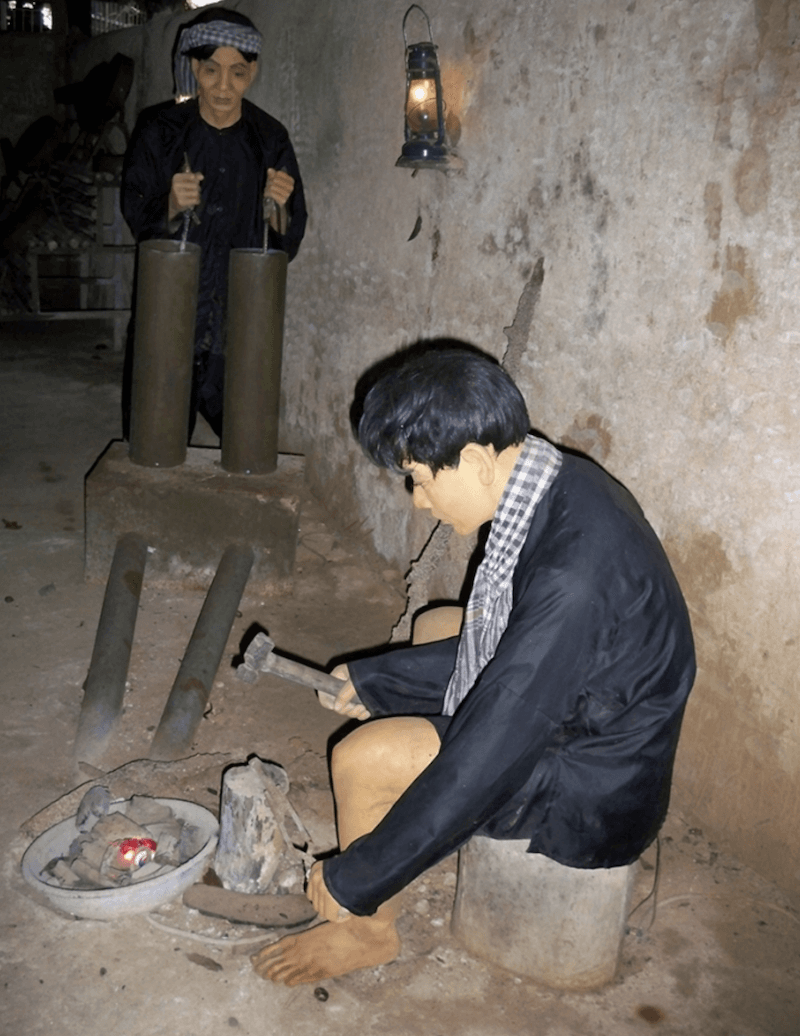
Impact on the War
The Cu Chi tunnels significantly influenced the outcome of the Vietnam War. They allowed the Viet Cong to survive intense bombing campaigns, including Operation Cedar Falls in 1967, which deployed 30,000 American troops specifically to destroy the tunnel system.
On January 18, 1967, tunnel rats from the 1st Battalion, 5th Infantry Regiment, 25th Infantry Division uncovered the Viet Cong district headquarters within the tunnels, seizing half a million documents containing military strategies, maps of U.S. bases, and detailed accounts of PLAF movement from Cambodia into Vietnam.
Despite this intelligence victory, American forces could not completely neutralize the tunnel threat. By 1969, B-52 bombers began “carpet bombing” Cu Chi and the surrounding Iron Triangle region. While this bombing campaign managed to collapse portions of some tunnels and expose others, most of the network remained functional.
The tunnels served as the launching point for portions of the 1968 Tet Offensive, allowing Viet Cong forces to stage surprise attacks throughout South Vietnam. By helping to covertly move supplies and house troops, the Cu Chi tunnels allowed North Vietnamese fighters to prolong the war, increase U.S. casualties, and contribute significantly to the American withdrawal in 1973 and the eventual fall of Saigon in 1975.
The Cu Chi Tunnels Today
A War Remnant
Today, the Cu Chi tunnels have been preserved as a war memorial and transformed into one of Vietnam’s most visited historical sites. Recognized for their historical significance, the tunnels were honored with the title of “Hero of Labor” in 2005 and designated as a special national historical site in 2016.
Approximately 120 kilometers of the original tunnel network have been preserved and are now maintained as part of the memorial complex. The site serves multiple purposes:
- A historical monument honoring the resilience and sacrifice of those who lived and fought from the tunnels;
- An educational resource for Vietnamese citizens and international visitors;
- A tangible reminder of the human cost of war.
The Cu Chi district government actively manages the conservation and promotion of the tunnels, implementing regular maintenance to prevent deterioration while preserving their historical authenticity.
Visiting the Tunnels Today
Visitors can experience the tunnels at two main locations:
- Ben Dinh Tunnels: Located closer to Ho Chi Minh City, this site has been reconstructed and enlarged to accommodate tourists. It focuses on demonstrations and interactive exhibits.
- Ben Duoc Tunnels: Five times larger than Ben Dinh, this site offers a more authentic experience with narrower passages that better represent original dimensions (though still modified for safety). It also houses the Cu Chi Tunnels Memorial Temple honoring fallen soldiers.

For safety and accessibility, sections of the tunnels have been reinforced with cement and equipped with lighting. Emergency exits are positioned every 10 meters throughout tourist-accessible sections. The original tunnels were extremely narrow-built to fit the smaller frames of Vietnamese fighters while excluding larger American soldiers-but portions have been widened to accommodate visitors.
Beyond the tunnels themselves, the sites feature:
- Introductory documentaries explaining the historical context;
- Demonstrations of booby traps and tunnel entrances;
- Exhibits showcasing living conditions and military strategies;
- Opportunities to sample traditional tapioca with peanut salt (a staple food during wartime);
- A shooting range where visitors can fire historical weapons (for an additional fee).
FAQs
How long are the Cu Chi Tunnels?
The original Cu Chi tunnel system stretched over 250 kilometers (approximately 155 miles) at its peak, with multiple levels extending as deep as 12 meters underground. Today, approximately 120 kilometers of the tunnels have been preserved as part of the historical complex, with only small sections (typically 100-120 meters) open for tourists to experience.
How many people lived in the Cu Chi Tunnels?
While exact numbers are difficult to determine, thousands of Vietnamese soldiers and civilians lived in the tunnels during the height of the Vietnam War. Entire villages moved underground during periods of intense bombing, with the tunnel system functioning as a complete subterranean community. Around 45,000 Vietnamese men and women died defending the Cu Chi tunnels throughout the conflict.
Are all of the Cu Chi Tunnels open to the public?
No, only small sections of the tunnels at Ben Dinh and Ben Duoc sites are accessible to visitors. These sections have been widened, reinforced, and equipped with lighting and emergency exits to ensure tourist safety. The majority of the preserved 120 kilometers remains closed to the public due to safety concerns and preservation efforts.
What happened to the Cu Chi Tunnels after the war?
After the Vietnam War ended in 1975, portions of the tunnels were preserved as historical monuments. The Vietnamese government recognized their historical significance and began developing the site as a war memorial in the early 1990s. In 1994, the Municipal People’s Committee of Ho Chi Minh City assigned the Municipal Military Command to manage “the Cu Chi Tunnel Relic Site.” Since then, the tunnels have been maintained and developed as a major tourist attraction, educational resource, and war memorial, receiving official recognition as a special national historical site in 2016.
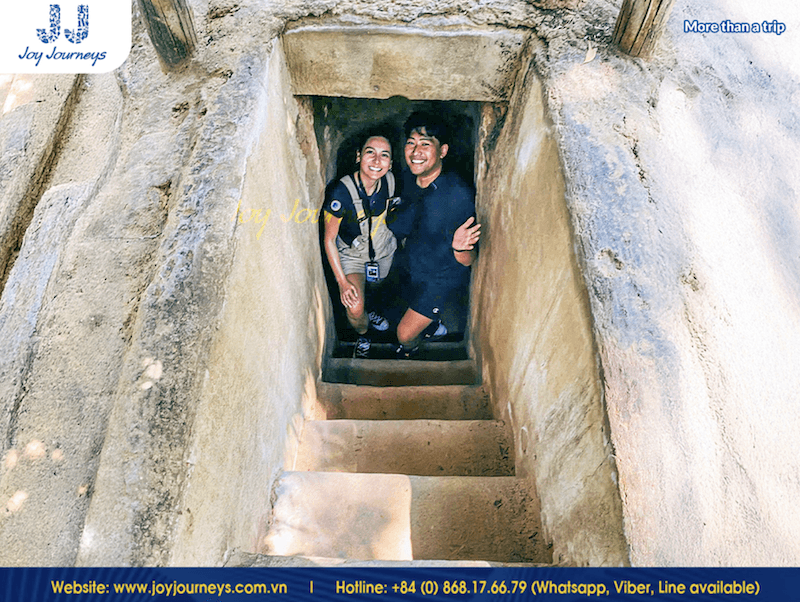
The Cu Chi tunnels history represents one of the most remarkable chapters in Vietnam’s long struggle for independence. These underground passages not only showcase extraordinary engineering achievements carried out with minimal resources, but also embody the fierce determination of a people defending their homeland. Today, they stand as a powerful reminder of human resilience and the devastating impact of war on communities and landscapes.
For detailed information and booking assistance for Cu Chi Tunnels tours, feel free to contact Joy Journeys through the following channels:
- Website: joyjourneys.com.vn
- Hotline: +84 (0) 868.17.66.79
- Email: inquiry@joyjourneys.com.vn
Our team is ready to help you choose the Cu Chi Tunnels tour that best suits your schedule and interests!



Related Posts
Saigon’s “Flower Market Replica”: Where To Find Them
Ho Chi Minh City’s floral charm is not limited to its bustling wholesale markets. Imagine wandering through a place where vibrant petals, fragrant blooms, and the spirit of traditional Vietnamese markets come alive—without the overwhelming crowds. A flower market replica captures that magic, blending the beauty of fresh flowers with the charm of a curated, […]
Is it Safe to Travel to Vietnam Right Now? A Complete 2025 Guide
Vietnam has emerged as one of Southeast Asia’s most captivating destinations, drawing millions of visitors annually with its rich culture, stunning landscapes, and incredible cuisine. However, many travelers still ask: Is it safe to travel to Vietnam right now? This comprehensive guide provides you with everything you need to know about Vietnam travel safety in […]
Ho Chi Minh Cu Chi Tunnels Tour: The Ultimate Guide
The Cu Chi Tunnels stand as one of Vietnam’s most remarkable historical sites, offering visitors a profound glimpse into the ingenuity and resilience displayed during the Vietnam War. For travelers, a Ho Chi Minh Cu Chi tunnels tour represents an essential experience that combines education, adventure, and deep cultural understanding. This comprehensive guide will help […]